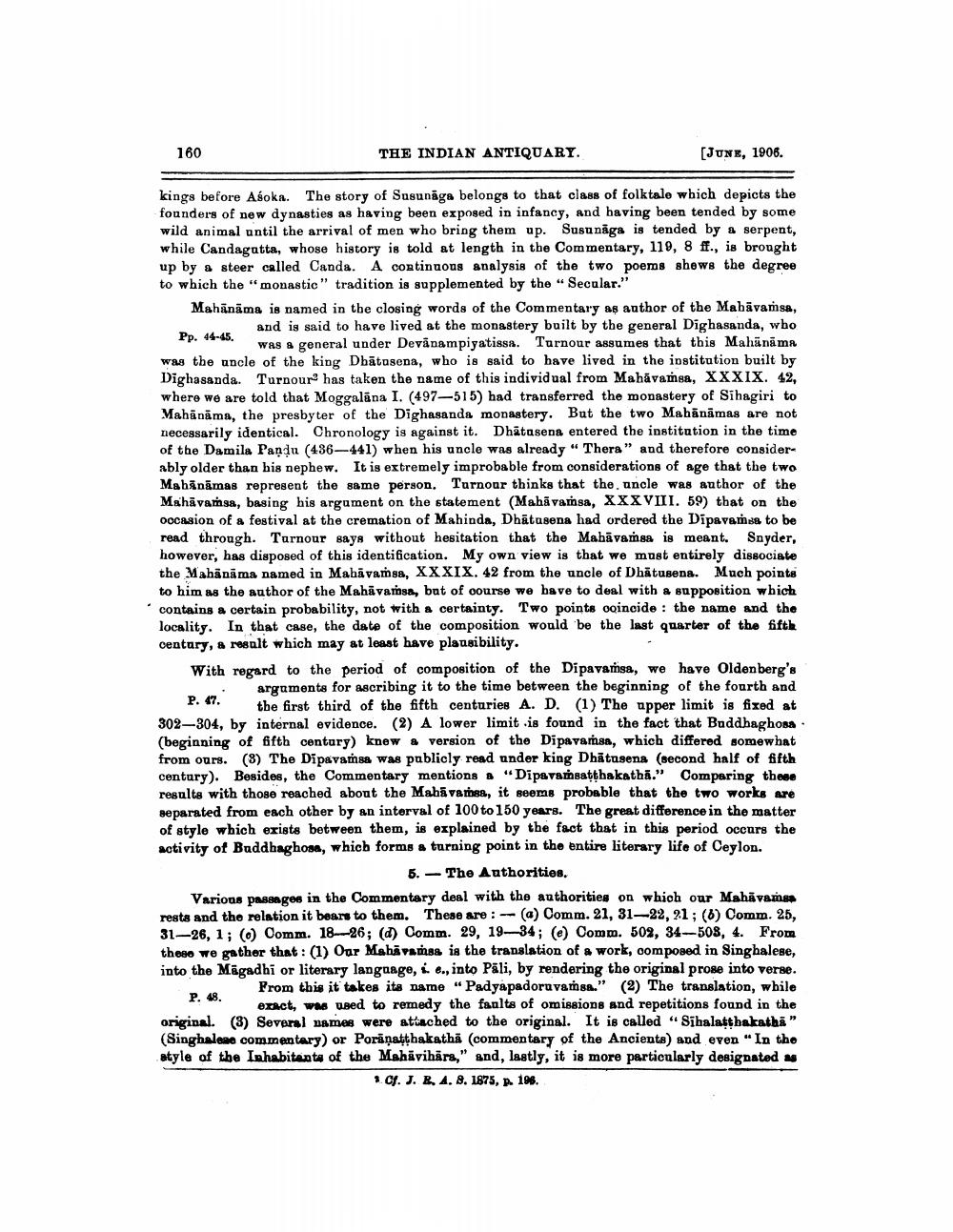________________
160
THE INDIAN ANTIQUARY.
(JUNE, 1906.
kings before Asoka. The story of Susunaga belongs to that class of folktalo which depicts the founders of new dynasties as having been exposed in infancy, and having been tended by some wild animal until the arrival of men who bring them up. Susunaga is tended by a serpent, while Candagatta, whose history is told at length in the Commentary, 119, 8 ff., is brought up by a steer called Canda. A continuons analysis of the two poems shows the degree to which the "monastic" tradition is supplemented by the " Secular." Mahānāma is named in the closing words of the Commentary as anthor of the Mabāvamsa,
and is said to have lived at the monastery built by the general Dighasanda, who Pp. 44-45.
****. was a general under Devanampigatissa. Turnour assumes that this Mahänāma was the uncle of the king Dbātusena, who is said to have lived in the institution built by Dighasanda. Turnour' has taken the name of this individual from Mahavamsa, XXXIX. 42, where we are told that Moggalāna I. (497—515) had transferred the monastery of Sihagiri to Mahānāma, the presbyter of the Dighasanda monastery. But the two Mahānāmas are not necessarily identical. Chronology is against it. Dhātasena entered the institution in the time of the Damila Pandu (436-441) when his uncle was already " Thera" and therefore considerably older than his nephew. It is extremely improbable from considerations of age that the two Mahānāmas represent the same person. Tarnour thinks that the uncle was author of the Mahāvamsa, basing his argument on the statement (Mahāvamsa, XXXVIII. 59) that on the occasion of a festival at the cremation of Mahinda, Dhātasena had ordered the Dipavamsa to be read through. Tarnour says without hesitation that the Mahāvamsa is meant. Snyder, however, has disposed of this identification. My own view is that we must entirely dissociate the Mahānama named in Mahavamsa, XXXIX. 42 from the uncle of Dhatusena. Much points to him as the author of the Mahāvarsa, but of course we have to deal with a supposition which contains a certain probability, not with a certainty. Two points ooincide : the name and the locality. In that case, the date of the composition would be the last quarter of the fifth century, a result which may at least have plausibility. With regard to the period of composition of the Dipavamsa, we have Oldenberg's
arguments for ascribing it to the time between the beginning of the fourth and P. $. the first third of the fifth centuries A. D. (1) The upper limit is fixed at 302-304, by internal evidence. (2) A lower limit is found in the fact that Buddhaghosa. (beginning of fifth century) knew & version of the Dipavamsa, which differed somewhat from ours. (8) The Dipavansa was publicly read under king Dhātusena (second half of fifth century). Besides, the Commentary mentions & “Dipavamsatthakatha." Comparing these results with those reached about the Mahā varsa, it seems probable that the two works are separated from each other by an interval of 100 to 150 years. The great difference in the matter of style which exists between them, is explained by the fact that in this period occurs the activity of Buddhaghose, which forms a turning point in the entire literary life of Ceylon.
5. - The Authorities, Various progon in the Commentary deal with the authorities on which our Mahavamsa rests and the relation it bears to them. These are : -- (a) Comm. 21, 31-22, 21; (6) Comm. 25, 31-26, 1; (6) Comm. 18-26; (d) Comm. 29, 1934; (@) Comm. 50%, 34-508, 4. From these we gather that: (1) Our Mahavamsa is the translation of a work, composed in Singhalese, into the Magadhi or literary language, 1 e., into Pāli, by rendering the original prose into verde.
From this it takes its name “Padyapadoruvamsa." (2) The translation, while " exact, was used to remedy the fanlts of omissions and repetitions found in the original. (3) Several names were attached to the original. It is called "Sihalatthakatha" (Singhaleno commentary) or Poriņaţthakathā (commentary of the Ancienta) and even "In the style of the Inhabitants of the Mahävihars," and, lastly, it is more particularly designated »
. Cf. J. B 4. 8. 1875, p. 195.




